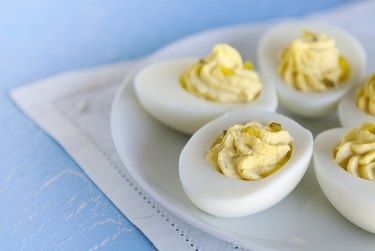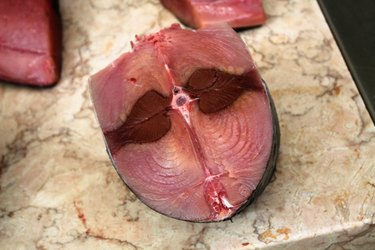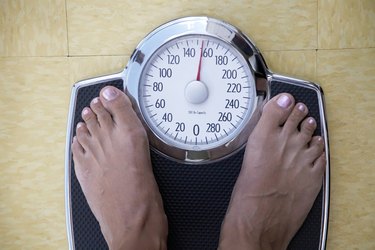
The Three-day AHA diet is one of the many names given to a rapid weight loss program that promises to help you lose 10 pounds in 36 hours if you strictly adhere to all of the instructions. Also called the Cleveland Clinic Three-day diet, the Cardiac diet and the Birmingham Hospital Cardiac Unit diet, the AHA diet purports to have been developed by the American Heart Association. The organization, however, denies all connection with the program. Most reputable medical institutions contend that the Three-day AHA diet is unhealthy and a poor choice for people seeking steady, sustainable weight loss.
Meal Plan
Video of the Day

The Three-day AHA diet consists of highly specific instructions for breakfast, lunch and dinner menus. Few substitutions are allowed. On the first day of the diet, you are instructed to eat half of a grapefruit for breakfast accompanied by a slice of toast spread with peanut butter, another slice of toast with 1/2 cup tuna fish for lunch and 3 ounces of lean beef, chicken, fish or pork paired with green beans, carrots, an apple and 1 cup of vanilla ice cream. Breakfast on Day 2 consists of an egg, toast and a banana, while lunch is five saltine crackers with 1 cup of cottage cheese or tuna fish. Dinner is two hot dogs along with carrots, broccoli or cabbage, a banana and ice cream. On the final day of the diet, you'll eat saltine crackers with cheddar cheese and an apple for breakfast, a hard-boiled egg and toast for lunch and 1 cup each of tuna fish, cauliflower, carrots and melon for dinner along with more vanilla ice cream.
Video of the Day
Guidelines

The Three-day AHA instructions direct you to drink water, diet soda, unsweetened tea and black coffee daily but strictly specify that you are not allowed to use seasonings other than salt, pepper, lemon juice and mustard or eat any snacks in between meals. Proponents of the diet claim that changing any of the menu foods or amounts will prevent you from losing the optimal amount of weight. They contend that the diet works because the specific food combinations stimulate an increase in your rate of metabolism. Followers of the diet are encouraged to eat normally for four days after completing the plan's three days, after which they can resume the diet again.
Possible Risks

If you follow the Three-day AHA diet exactly, you'll consume only between 600 and 1,100 calories daily. Diets that require such a restricted caloric intake can push your body into starvation mode, causing you to metabolize lean muscle and other body tissues for energy which can strain the kidneys and liver. Restrictive diets of this type can also cause you to develop nutritional deficiencies, increasing your chance of developing mineral and electrolyte imbalances, anemia, brittle hair and nails, depression and osteoporosis. Eating less than 1,000 calories per day may not provide you with enough blood glucose to keep your brain and nervous system working properly. Additionally, the Three-day AHA diet may encourage yo-yo dieting which can increase your risk of gallstones.
Expert Insight

The American Heart Association warns that the Three-day AHA diet did not originate with their organization and does not conform to the AHA recommendation to limit cholesterol and saturated fat intake by avoiding foods included in the plan, such as hot dogs and ice cream. According to the AHA, the best way to lose weight and prevent cardiovascular disease is not to follow a short-term restrictive diet, but to eat a wide variety of low-fat foods like fruits, vegetables, whole grains and lean protein and to engage in 30 minutes of moderate-intensity exercise most days of the week.